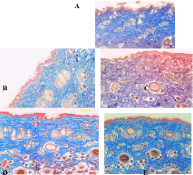The Effect of Noni (Morinda citrifolia) Extract Gel on Collagen Density and Expression of p53 Protein in Rats Exposed to UVB
Main Article Content
Abstract
The skin consists of collagen fibers, which play a role in maintaining the stability of the skin and regeneration of damaged cells. Several studies have shown that exposure to UVB typically causes a decrease in the production of collagen fibers. Noni (Morinda citrifolia) has been reported to be an effective medicinal plant with strong antioxidant activity. Therefore, this study aimed to determine the effect of noni gel on collagen density and p53 protein expression in rats exposed to UVB. Twenty-Five male Wistar rats were divided into five groups of five rats each, and treated as follows; Group I consisted of healthy rats not exposed to UVB, Group II consisted of rats exposed to UVB, while Groups III, IV, and V were consisted of rats exposed to UVB and treated with gel base, noni extract gel (10%), and tretinoin (vitacid 0.025%) gel, respectively. UVB exposure was carried out for 5 days/week over a period of 14 days. On the 14th day, skin tissues were collected and assessed for collagen using Masson's Trichrome staining, and p53 expression was assayed by polymerase chain reaction (PCR) technique. The results showed that noni extract gel significantly increased collagen density, and significantly decreased p53 gene expression in the skin of UVB-exposed rats. The effects were comparable to that of the positive control (tretinoin). These observations suggest that noni extract could be a natural source of compound(s) with potential anti-aging properties that could be used in the prevention and treatment of photo-induced aging.
Downloads
Article Details

This work is licensed under a Creative Commons Attribution-NonCommercial-NoDerivatives 4.0 International License.
How to Cite
References
Hughes BK and Bishop CL. Current Understanding of the Role of Senescent Melanocytes in Skin Ageing. Biomed. 2022; 10(12):3111.
Winterbourn CC. Reconciling the chemistry and biology of reactive oxygen species. Nat Chem Biol. 2008; 4:278–286
Latonen L and Laiho M. Cellular UV damage responses - Functions of tumor suppressor p53. Biochim Biophys Acta. 2005; 1755:71–89
Feroz W and Ali Sheikh M. Exploring the multiple roles of guardian of the genome: P53. Egypt J Med Hum Genet. 2020; 21:49.
Budden T, Gaudy-Marqueste C, Porter A, Kay E, Gurung S, Earnshaw CH, Roeck K, Craig S , Víctor Traves V. Krutmann J, Muller P, Motta L, Zanivan S,Malliri A, Fumey SJ, Nagore E, Virós A. Ultraviolet light-induced collagen degradation inhibits melanoma invasion. Nat Commun. 2021; 12(1):2742.
Shin JW, Kwon SH, Choi JY, Na JI, Huh CH, Choi HR, Park KC. Molecular Mechanisms of Dermal Aging and Antiaging Approaches. Int J Mol Sci. 2019; 20:2126.
Ayunda N, Zulharmita, Azizah Z, Rivai H. Review of Phytochemical and Pharmacological Activities of Noni (Morinda citrifolia L.) Merisa. Scholars Acad J Pharm. 2020; 9(12):340-346.
Chanthira Kumar H, Lim XY, Mohkiar FH, Suhaimi SN, Mohammad Shafie N, Chin Tan TY. Efficacy and Safety of Morinda citrifolia L. (Noni) as a Potential Anticancer Agent. Integr Cancer Ther. 2022; 21(1):15347354221132848.
Li C, Fu Y, Dai H, Wang Q, Gao R, Zhang Y. Recent progress in preventive effect of collagen peptides on photoaging skin and action mechanism. Food Sci Hum Wellness. 2022; 11(2):218–229.
Lay DS, Sugiritama WI, Linawati NM, Arijana NIGK. The Effects of Noni (Morinda citrifolia) Ethanol Extract Cream on Collagen Deposition in Incisional Wound Healing of Male Wistar Rats. Int J Sci Res. 2019; 8(5):419-423.
Trieu HL, Trang NMP, Oanh TKN, Quynh TPB, Xu K, Minh VL. Phytochemical analysis and wound-healing activity of noni (Morinda citrifolia) leaf extract. J Herbs Spices Med Plants. 2020; 26(4):379‐393.
Baidoo N, Sanger GJ, Belai A. Histochemical and biochemical analysis of collagen content in formalin-fixed, paraffin embedded colonic samples.. MethodsX. 2023; 11:102416.
Sharun K, Banu SA, Mamachan M, Subash A, Mathesh K, Kumar R, Vinodhkumar OR, Dhama K, Abualigah L, Pawde AM, Amarpal. Comparative Evaluation of Masson's Trichrome and Picrosirius Red Staining for Digital Collagen Quantification Using ImageJ in Rabbit Wound Healing Research. J Exp Biol Agric Sci. 2023; 11(5):822–833.
Pittayapruek P, Meephansan J, Prapapan O, Komine M, Ohtsuki M. Role of matrix metalloproteinases in Photoaging and photocarcinogenesis. Int J Mol Sci. 2016; 17(6):868.
Cole MA, Quan T, Voorhees JJ, Fisher GJ. Extracellular matrix regulation of fibroblast function: redefining our perspective on skin aging. J Cell Commun Signal. 2018; 12(1):3510.
Suwanto YA, Chodidjah, Hussaana A. The Effect of Alfalfa (Medicago sativa) extract onthe number of macrophage, fibroblast, and amount of coll agen in rat wound healing. Bangladesh J Med Sci. 2023; 22(1):77-83.
Choi SC and Youn YH. Anti-wrinkling effect of noni (Morinda citrifolia) by antioxidant and anti-inflammatory properties. J People Plants Environ. 2020; 23(2):191–199.
Hutapea CM, Subchan P, Putra A. Clitoria ternatea Flower Extract-Based Gel Elevates TGF-β1 Gene Expression and Collagen Density in UVB-Induced Collagen Loss Rat Skin. J Kedokteran Brawijaya 2023; 32(3):148-153.
Kwon KR, Alam MB, Park JH, Kim TH, Lee SH. Attenuation of UVB-induced photoaging by polyphenolic-rich spatholobus suberectus stem extract via modulation of MAPK/AP-1/MMPs signaling in human keratinocytes. Nutrients. 2019; 11(6):1341.
Chen B, Li R, Yan N, Chen G, Qian W, Jiang HL, Ji C, Bi ZG. Astragaloside IV controls collagen reduction in photoaging skin by improving transforming growth factor-β/Smad signaling suppression and inhibiting matrix metalloproteinase-1. Mol Med Rep. 2015; 11(5):3344-3348.
Benjamin CL, Ullrich SE, Kripke ML, Ananthaswamy HN. p53 tumor suppressor gene: A critical molecular target for UV induction and prevention of skin cancer. Photochem Photobiol. 2008; 84(1):55–56.
Green D and Kroemer G. Cytoplasmic functions of the tumor suppressor p53. Nature. 2009; 458(7242):1127-1130.
Verschooten L, Declercq L, Garmyn M. Adaptive response of the skin to UVB damage: Role of the p53 protein. Int J Cosmet Sci. 2006; 28(1):1–7.
Brady C and Attardi L. p53 at a glance. J Cell Sci. 2010; 123(15):2527-2532.


